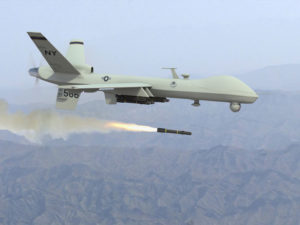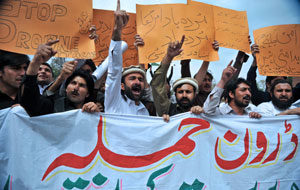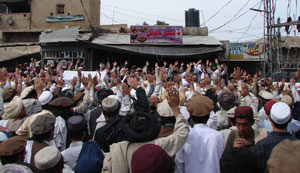Hi-Tech and High Risk
By Rahimullah Yusufzai | News & Politics | Published 14 years ago
 There have been deadlier US drone attacks in Pakistan’s tribal areas in the past seven years including the one on a madrassa in Damadola in Bajaur Agency in which 83 — mostly young religious students — were killed, but the one on March 17 in North Waziristan was different due to the fact that there was not the slightest doubt that those killed and injured were all innocent civilians.
There have been deadlier US drone attacks in Pakistan’s tribal areas in the past seven years including the one on a madrassa in Damadola in Bajaur Agency in which 83 — mostly young religious students — were killed, but the one on March 17 in North Waziristan was different due to the fact that there was not the slightest doubt that those killed and injured were all innocent civilians.
In the past, with such attacks, there was always an element of doubt because Pakistan’s security officials, local sources or the US would point to the presence of militants among the dead and injured. Their claims would be unsubstantiated because outsiders had no access to the bombed sites, but there would be this feeling that perhaps militants were present in the area at the time of the drone strike or had used the targeted site for their activities in the past. If there was a misdirected hit or civilian casualties, the US officials would leak information to their own sympathetic press about the reported presence of a high-value target, someone like the Al Qaeda number two Dr Ayman al-Zawahiri, in the compound under attack to justify the strike. This strategy worked and the civilians who may have lost their lives in such failed attacks would be conveniently dumped under the category of ‘collateral damage’ and forgotten.
No such excuse was available to justify the deadly missile strike by the US drones on the tribal gathering at Dattakhel on March 17. It was a jirga of a section of the Madakhel Wazir tribe convened in keeping with tribal traditions to discuss a local dispute involving shares of clans from a lease given to a contractor, Sharbat Khan, for mining chromite in a collectively owned hill. The contractor had to pay Rs 8.8 million for the lease and the jirga was to discuss with him the schedule of payment and the share of the amount that had to go to each tribal clan. Jirga members often sit in a circle on the ground and take unanimous decisions. Commoners also come along and listen as they aren’t supposed to take part in the proceedings. According to reports there were around 150 people at this gathering, among them many children. And the 45 people who lost their lives that day included tribal elders, commoners and children.
Every tribe has its share of khassadars, the tribal police force made up of local tribesmen and recruited by the government to provide security to government installations and officials in each of the seven Federally Administered Tribal Areas (FATA). Thus a number of off-duty khassadars were also among the dead. Around 50 tribesmen were wounded, and with great difficulty they were shifted to Miramshah, the headquarters of North Waziristan, to the only functioning yet ill-equipped public hospital there. The government hospital in Dattakhel is under the use of the security forces, whose numbers have been swelling in the area due to past military operations and future planning, and are in need of space and medical facilities. In fact, during a visit to Dattakhel a few days before the US drone strike, the political agent, or administrator, for North Waziristan was requested by local tribal elders to provide the people with an alternate medical facility, or get the public hospital vacated.
A section of the western media wrongly mentioned Sharbat Khan, the local contractor, as a Taliban commander, as if trying to justify the unjustifiable drone attack. Even if there were a few militants from the local village or tribe in the gathering, for which there is no evidence, attacking such a large group of civilians on this pretext has no justification. Those who know the tribal areas are aware that many tribesmen carry weapons, and so if some men were armed, it was no big deal. Militants don’t run a training camp in such an open place near the village by the banks of river Tochi in an area that is under surveillance round the clock by the CIA-operated unmanned aerial vehicles (UAV). They also don’t gather at one place in such large numbers after having suffered losses in previous drone attacks in North Waziristan.
 It was such a blatant attack on civilians that no amount of spin could have hidden the truth and stopped information from reaching the media. Once the government and the army realised that the jirga had been attacked and innocent tribesmen killed, no effort was made to give the incident a twist. The authorities normally provide some justification for the drone strikes in keeping with government policy, which is based on protesting the attacks in public and supporting them in private — as revealed by American diplomatic cables leaked to WikiLeaks. After all, President Asif Ali Zardari and Prime Minister Yousaf Raza Gilani were quoted as telling the US ambassador Anne Patterson that they had no objection to the drone attacks in Pakistan’s tribal areas as long as the right targets, meaning the militants, were targeted. But when no militants were hit and civilians were attacked on March 17 both the President and the Prime Minister publicly condemned the drone strike. The army chief General Ashfaq Parvez Kayani also came out against the attack with a strong-worded statement. However, none of them talked about taking steps to put an end to the attacks by the US drones and it soon became obvious that the same ambiguous government policy of publicly condemning the strikes by the UAVs and privately condoning them would continue.
It was such a blatant attack on civilians that no amount of spin could have hidden the truth and stopped information from reaching the media. Once the government and the army realised that the jirga had been attacked and innocent tribesmen killed, no effort was made to give the incident a twist. The authorities normally provide some justification for the drone strikes in keeping with government policy, which is based on protesting the attacks in public and supporting them in private — as revealed by American diplomatic cables leaked to WikiLeaks. After all, President Asif Ali Zardari and Prime Minister Yousaf Raza Gilani were quoted as telling the US ambassador Anne Patterson that they had no objection to the drone attacks in Pakistan’s tribal areas as long as the right targets, meaning the militants, were targeted. But when no militants were hit and civilians were attacked on March 17 both the President and the Prime Minister publicly condemned the drone strike. The army chief General Ashfaq Parvez Kayani also came out against the attack with a strong-worded statement. However, none of them talked about taking steps to put an end to the attacks by the US drones and it soon became obvious that the same ambiguous government policy of publicly condemning the strikes by the UAVs and privately condoning them would continue.
The government subsequently decided to compensate the victims of this drone attack by paying Rs300,000 to the heirs of the 45 tribesmen who were slain and Rs100,000 to every injured person. This was the first time that the government and the military officials not only offered condolences to the bereaved families, but also decided to give them compensation. In the past 232 drone attacks in Pakistani territory by the US since June 2004, nobody in the government has offered condolences to the families of those who were killed. The tribespeople were largely left to fend for themselves. In practice, they were pushed into the arms of the militants who exploited the drone attacks by the US to justify their acts of retaliation both against the Americans and the Pakistan government and security forces. The civilian casualties have also radicalised the affected communities and this was evident when some members of the grand tribal jirga, also known as the North Waziristan Peace Committee, declared jihad against the US after the March 17 drone strike. Though the main leaders of the committee, led by Maulana Gul Ramzan and the leading tribal elders such as Malik Nasrullah Khan, Malik Qadir Khan and Malik Mamoor, didn’t endorse the call for jihad, it was obvious that they faced a difficult task in calming down the young tribesmen agitated by the civilian killings.
The peace committee also helped avert the breakdown of the fragile peace accord still in place in North Waziristan after a warning by the Taliban militants led by Hafiz Gul Bahadur that they were considering unilaterally scrapping the agreement to protest the government’s complicity in allowing the US to carry out strikes. The accord isn’t really working if one goes by its terms as there have been violations by all sides, but the tribesmen and the tribal jirga in North Waziristan are desperate to save it to avoid another round of fighting, bloodshed and displacement in their area. So although the peace accord is still intact, it is uncertain and could collapse at any moment.
 The US would be pleased if the peace accord were to collapse. In fact, even after the misdirected drone strike, the US military commander in Afghanistan, General David Petraeus once again asked Pakistan to launch a military operation in North Waziristan against the militants. This is an old US demand, but the Pakistan government and military have been arguing that they would decide this issue at their own time keeping in view their priorities. The government has also been arguing that it cannot spare its troops — already committed in different fronts in Khyber Pakhtunkhwa and the adjoining FATA — to launch new military operations.
The US would be pleased if the peace accord were to collapse. In fact, even after the misdirected drone strike, the US military commander in Afghanistan, General David Petraeus once again asked Pakistan to launch a military operation in North Waziristan against the militants. This is an old US demand, but the Pakistan government and military have been arguing that they would decide this issue at their own time keeping in view their priorities. The government has also been arguing that it cannot spare its troops — already committed in different fronts in Khyber Pakhtunkhwa and the adjoining FATA — to launch new military operations.
Meanwhile, the US has yet to concede that its missiles killed 45 civilians and injured around another 50 in the drone strike on March 17. However, that is par for the course as normally too it does not comment officially on the drone strikes in Pakistan, even while CIA chiefs have been full of praise for the accuracy of these attacks and have described them as “the only game in town.” US officials, requesting anonymity in their interaction with their media, have been providing figures as to the number of militants, including Al Qaeda members, killed in the drone strikes. While the drones have certainly killed militants, the number of Al Qaeda members killed in the last seven years is not more than 25, and the majority of those slain were Pakistanis, not Afghans or other foreigners who pose the real threat to the US and NATO forces in Afghanistan and often threaten to target the interests of western countries. While some of the most dangerous Pakistani militants, such as Baitullah Mahsud, Haji Omar, Qari Hussain and others, fighting the Pakistan government and military have been taken out by US drones, a majority of those killed to date have been civilians, including women and children, and the militants who were eliminated were unknown foot soldiers rather than any wanted commanders.
There are two theories for the bloody March 17 US drone strike in North Waziristan. One is that it was a mistake, although those in awe of the Predators and Reapers would be disappointed that the drones could go wrong and kill so many civilians. According to this account, the drones were trying to hit a vehicle carrying five militants, who were eventually killed, but in the process the jirga members holding their meetings nearby were also slain.
The other theory is that it was an act of revenge by the US after the CIA had to cut an embarrassing deal with the ISI to secure freedom for its operative Raymond Davis and accept the ISI’s demands; not only to pay a huge amount as blood-money to the families of the two men killed by Davis in Lahore, but also reveal the number and activities of its secret agents operating in Pakistan. It is said that the US also wanted to cause the scrapping of the peace deal in North Waziristan and would do anything to achieve this goal, as it had done in the past in South Waziristan and Bajaur to scuttle peace talks and agreements.
Whatever the truth, the North Waziristan story isn’t going to go away. There will be more drone strikes and the Pakistan military could finally be forced to take some action, howsoever, selective against the local and foreign militants hiding there. The US will definitely want action against the Haqqani Network, a powerful faction of the Afghan Taliban, but it is unlikely that even a big military operation would inflict any harm on the Haqqanis and reduce America’s troubles in Afghanistan.
Rahimullah Yusufzai is a Peshawar-based senior journalist who covers events in the NWFP, FATA, Balochistan and Afghanistan. His work appears in the Pakistani and international media. He has also contributed chapters to books on the region.


